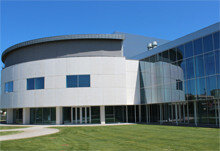
Nobel Laureate Harold Kroto gave lecture at INL
May 25, 2012
Sir Harold Kroto, one of the co-recipients of the 1996 Nobel Prize in Chemistry delivered (June 1st) at INL, in Braga (Portugal) a lecture entitled «Carbon in Nano and Outer Space».
The Nobel laureate stressed the importance of improving the general level of scientific understanding and awareness worldwide. «Acceptance of the truth» should go hand in hand with «understanding the truth».
Harold Kroto invited the young scientists in the audience to address present challenges and to think out of the box, to focus their creativity and commitment in the subject they feel genuinely passionate about.
Referring to the importance of the discovery of penicillin and anaesthetics and its impact on the improvement of human well-being, Kroto directed the attention to a present challenge: the decreasing effectiveness of antibiotics.
Prof. Kroto began his lecture telling the story of his and his colleagues’ odyssey towards the discovery of C60. In 1970 his research group conducted laboratory began spectroscopic studies on long linear carbon chain molecules with colleague David Walton. This research led to radio astronomy searches with Takeshi Oka and Canadian astronomers (Lorne Avery, Norman Broten and John McLeod) at the National Research Council in Canada which made the surprising discovery that they existed in unusually copious amounts in certain regions of interstellar space.
At the same time, he developed flash thermolytic synthetic methods to create new metastable species and intermediates with multiple bonds between carbon and second and third-row atoms (S, Se and P) and applied microwave spectroscopic techniques to detect and characterise them. The work on multiply bond carbon-phosphorus species (with Sussex colleague John Nixon) created the first molecule with a C=P double bond and the second with a C≡P triple bonded species. The general synthetic techniques developed opened up the exciting new fields of Phosphaalkene and Phospahalkyne Chemistry. Conclusions derived from the earlier radioastronomy breakthrough on carbon species in space led to experiments in 1985 together with Robert Curl, Richard Smalley and research students Jim Heath, Sean O’Brien and Yuan Liu at Rice Univer¬sity (Texas). These laboratory experiments which simulated the chemical reactions in the atmospheres of red giant stars uncovered the existence C¬60 Buckminsterfullerene, the third well characterised form of carbon, for which he together with Curl and Smalley received the 1996 Nobel Prize in Chemistry.
Kroto is heavily involved with GEOSET, a Global Educational Outreach for Science, Engineering, and Technology programme which he initiated. The programme seeks to exploit the revolutionary creative dynamics of the Internet to improve the general level of scientific understanding and awareness worldwide.
Kroto is currently a Francis Eppes Professor of Chemistry at Florida State University, where he is carrying out research in nanoscience and cluster chemistry as well as developing exciting new Internet approaches to STEM (Science, Technology, Engineering, Math) educational outreach. He is a Fellow of the Royal Society of London and holds an emeritus professorship at the University of Sussex in Brighton, United Kingdom.
The research program focuses on the complex range of molecular constituents in carbon valour; the development of novel 2 and 3D metal-cluster/organic frameworks as well as peptides; the stabilisation of small fullerenes; and carbon nanotube-based devices behaviour.